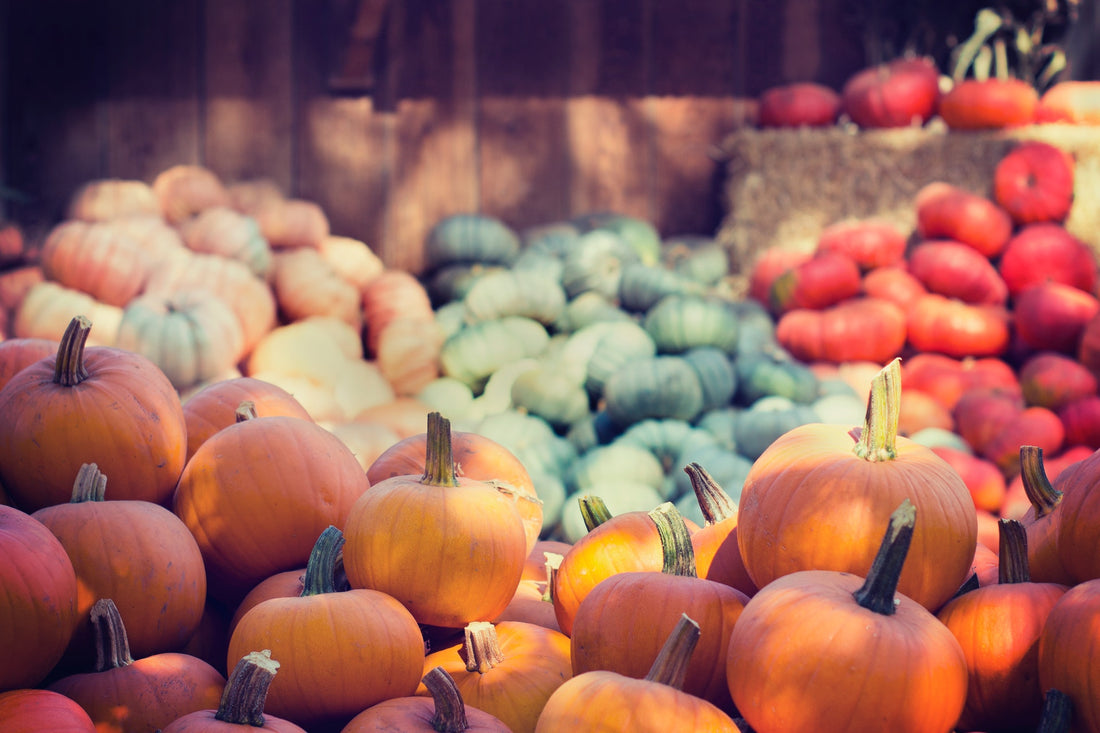
Fall in Love With Fall Foods: Healthy Produce Choices For a New Season
Share
This month marks the end of summer (September 23rd, to be exact). The change of seasons brings about many changes in life, and also brings about a new batch of seasonal fall foods — crabapples and cranberries and, of course, the quintessential pumpkin. Not only does this seasonal bounty celebrate the shift in sunlight and cooler temperatures, but it’s also an invitation to boost your immune system with exceptionally healthy, local produce.
“Buying seasonal produce at your local farmers’ market is an excellent opportunity to get your family outside walking, but the health benefits don’t end there,” explains Purdue University. “Eating with the seasons encourages consumption of a greater variety of foods. Different fruits and vegetables contain varying amounts of vitamins, minerals, antioxidants, and other important nutrients. Not to mention that the foods you will be eating are fresher and often harvested at peak nutrition and ripeness.”
In today’s guide to fresh, seasonal fall foods, we’ll explore a few specific fall fruits and vegetables that are surprisingly healthy and bursting with flavor.
3 Seasonal Fall Foods to Try This Month
Every region is different and has different growing schedules, but in general, most of us have access to the following fall foods throughout September, October and November.
1. Pumpkin
 Of all the fall foods out there, few define the fall season quite like pumpkins. They serve as everything from holiday decor to a tasty dessert ingredient, but pumpkins are so much more than just a Halloween tradition and are far more versatile than just pumpkin pie!
Of all the fall foods out there, few define the fall season quite like pumpkins. They serve as everything from holiday decor to a tasty dessert ingredient, but pumpkins are so much more than just a Halloween tradition and are far more versatile than just pumpkin pie!
A single 1-cup serving of cooked, mashed pumpkin contains:
- Almost zero fat, and very few calories
- Nearly three times your daily requirements of vitamin A, a micronutrient that researchers say “is known as an anti-inflammation vitamin because of its critical role in enhancing immune function,” specifically in your cellular immune response.
- Impressive amounts of other immune-enhancing vitamins and minerals, including vitamin E, vitamin C and potassium
- A healthy 3 grams of digestion- and gut health-supporting fiber.
All these antioxidants may help to reduce your risks of most chronic diseases, including cancer.
Don’t wait for pumpkin pie. You can enjoy more pumpkin in your diet many different ways:
- Keep canned pumpkin in your pantry all year long (just watch out for added sugar)
- Use roasted pumpkin as an alternative to other roasted vegetables and roots
- Enjoy pumpkin seeds as a snack
- Add frozen cooked pumpkin, or pureed pumpkin, to smoothies and shakes
- Use pumpkin as a base for soups and sauces
2. Crab Apples
 Crab apples dot the trees of many orchards right now, and they’re a great way to celebrate fall foods. According to the USDA, a single crab apple provides:
Crab apples dot the trees of many orchards right now, and they’re a great way to celebrate fall foods. According to the USDA, a single crab apple provides:
- Fewer than 20 calories and only 5 grams of carbohydrates
- Healthy amounts of fiber
- Immune-enhancing vitamins like vitamin C and copper
Crab apples, just like their larger and more mature counterparts, are high in epicatechin and other flavanols. These compounds may help to support a healthier cardiovascular system and may even reduce your risks of stroke. These fall foods are also high in pectin, a specific type of fiber that may boost your gut health (and a healthier gut is linked with many health benefits, including a stronger immune response to bacteria and viruses)
3. Eggplant
 When it comes to fall foods, eggplant rarely gets the love and celebration that it deserves. While this vegetable may not be a staple in many North American households, it’s prized in delicious cuisine from around the world and it is at peak ripeness in the fall.
When it comes to fall foods, eggplant rarely gets the love and celebration that it deserves. While this vegetable may not be a staple in many North American households, it’s prized in delicious cuisine from around the world and it is at peak ripeness in the fall.
In just one cup of eggplant, you’ll find:
- Very few calories (less than 30)
- Ample amounts of fiber
- A small amount of protein
- High levels of micronutrients, including potassium, folate and vitamin K
But it’s an eggplant’s vibrant purple hue that lends many of its surprising health benefits. This purple color comes from anthocyanins, which protect your cells from damage. These antioxidants, anthocyanins also power-up your immunity right in time for cold and flu season.
Many people are turned off from eggplant because of its texture, which is easily solved by salting it and pressing it between clothes or paper towels to draw out excess moisture. The result is a delicious and versatile vegetable that you can roast, grill, sautee or bake, and it can add a meaty texture to all types of foods.
Try adding these three fall foods to your diet today, and see how these nutritional powerhouses add energy and vitality to your fall. They’re also a great complement to BioPro-Plus 500, working alongside this all-natural immunity booster to enhance and support the strength and resilience of your immune system and white blood cells.
References:
- https://www.purdue.edu/dffs/localfood/family/eatseasonal/
- https://nutritiondata.self.com/facts/vegetables-and-vegetable-products/2601/2
- https://www.ncbi.nlm.nih.gov/pmc/articles/PMC6162863/
- https://pubmed.ncbi.nlm.nih.gov/25157026/
- https://pubmed.ncbi.nlm.nih.gov/19149749/
- https://pubmed.ncbi.nlm.nih.gov/25726725/
- https://fdc.nal.usda.gov/fdc-app.html#/food-details/341508/nutrients
- https://pubmed.ncbi.nlm.nih.gov/22400181/
- https://nutritiondata.self.com/facts/vegetables-and-vegetable-products/2443/2
- https://pubmed.ncbi.nlm.nih.gov/25442541/
Interested in Fall Foods and a Healthy Fall Season? Keep Reading More:
